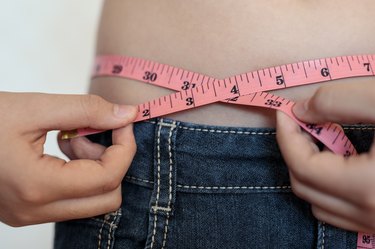
Stomach measurement is a simple way to track your weight loss progress and assess your risk of cardiometabolic problems. Your waistline says a lot about your health and may help predict your odds of getting diabetes and other related disorders. All you need is a measuring tape or skinfold calipers.
Tip
Waist size is a good indicator of cardiometabolic risk factors. Depending on your preferences, you may use a measuring tape, skinfold calipers, DXA or 3D body scanners to determine how much fat you have in the abdominal area.
Video of the Day
Why Your Waist Circumference Matters
Approximately 59 percent of American adults had abdominal obesity in 2015-2016, reports the Centers for Disease Control and Prevention. Abdominal fat isn't just unsightly but harmful too.
Video of the Day
The adipose tissue in this area consists of visceral and subcutaneous fat. The latter is found beneath your skin and seems to be negatively associated with cardiovascular risk factors, according to a November 2015 review published in Endocrinología y Nutrición.
Visceral fat (VAT), on the other hand, is metabolically active, producing inflammatory hormones, cytokines and other substances that affect overall health. MCP-1, for example, promotes insulin resistance, triggers inflammation and contributes to atherosclerosis. This type of adipose tissue wraps around your vital organs, keeping them from functioning properly.
As you age, abdominal subcutaneous fat is redistributed to VAT, explains the above review. Furthermore, the rate of VAT accumulation increases after menopause. In clinical trials, visceral fat has been linked to higher rates of diabetes, points out a June 2018 study featured in Cardiovascular Diabetology. This metabolic disease may double your risk of death from heart disease and affect cardiovascular function.
Considering these facts, it makes sense to keep an eye on your waistline. Stomach measurement can reveal essential information about your health. In fact, waist circumference is a better indicator than your waist-to-hip ratio for abdominal obesity, according to a June 2016 study published in the International Journal of Preventive Medicine.
Warning
A waistline of more than 35 inches in women and 40 inches in men may significantly raise the risk of developing diabetes, high blood pressure and heart disease, according to the National Heart, Lung, and Blood Institute.
Stomach Measurement Made Easy
Abdomen measurement is relatively simple. Harvard Health Publishing recommends using a measuring tape. Take off your shirt, exhale and wrap the tape around your stomach — just above the upper part of your hipbone. Stay relaxed and don't squeeze your abs.
Ideally, your waist size should be no more than 35 inches if you're a woman or 40 inches if you're a man. As discussed earlier, higher values may indicate that you're at risk for cardiovascular disease, hypertension and diabetes.
Read more: How to Estimate Your Body Fat Percentage
For a complete picture, measure your waist-to-hip ratio too. Wrap the tape around the largest part of your buttocks and then divide your waist circumference by your hip size. A healthy waist-to-hip ratio is below 0.9 for women and 1 for men, point out the experts at Harvard Health Publishing.
Consider using skinfold calipers for a more precise body composition measurement. This method is relatively accurate and inexpensive, according to the American Council on Exercise. It does have a 3.5 percent error rate, but it's a good way to measure your body composition at home.
All you need to do is to pinch your skin and underlying fat in several areas and then use an online calculator (like the one provided by the American Council on Exercise) to estimate your body fat levels. Take at least two measurements at each site.
Generally, skinfold calipers come with a body fat chart that you may use to determine your body composition, or fat-to-muscle ratio. Use this number in combination with your waist-to-hip ratio or stomach measurement for more accurate results.
Other methods used for abdomen measurement are DXA (Dual-Energy X-ray Absorptiometry) and 3D body scanners. DXA, for example, helps determine the percentage of fat, lean mass and bone mineral content in specific areas, such as the trunk region, explains a March 2013 review published in Nutrition and Diabetes. These methods are not widely available and can be expensive, but you may ask your doctor to recommend a clinic that offers either DXA or 3D body scanning.
- Centers for Disease Control and Prevention: "Indicator Details: Percentage With Abdominal Obesity by Survey Year"
- Endocrinología y Nutrición: "Different Adipose Tissue Depots: Metabolic Implications and Effects of Surgical Removal"
- Cardiovascular Diabetology: "Abdominal Subcutaneous Adipose Tissue: A Favorable Adipose Depot for Diabetes?"
- International Journal of Preventive Medicine: "Abdominal Obesity Indicators: Waist Circumference or Waist-to-Hip Ratio in Malaysian Adults Population"
- National Heart, Lung, and Blood Institute: "Classification of Overweight and Obesity by BMI, Waist Circumference, and Associated Disease Risks"
- Harvard Health Publishing: "Why Worry About Your Waistline?"
- American Council on Exercise: "Percent Body Fat Calculator: Skinfold Method"
- Nutrition and Diabetes: "DXA Estimates of Fat in Abdominal, Trunk and Hip Regions Varies by Ethnicity in Men"